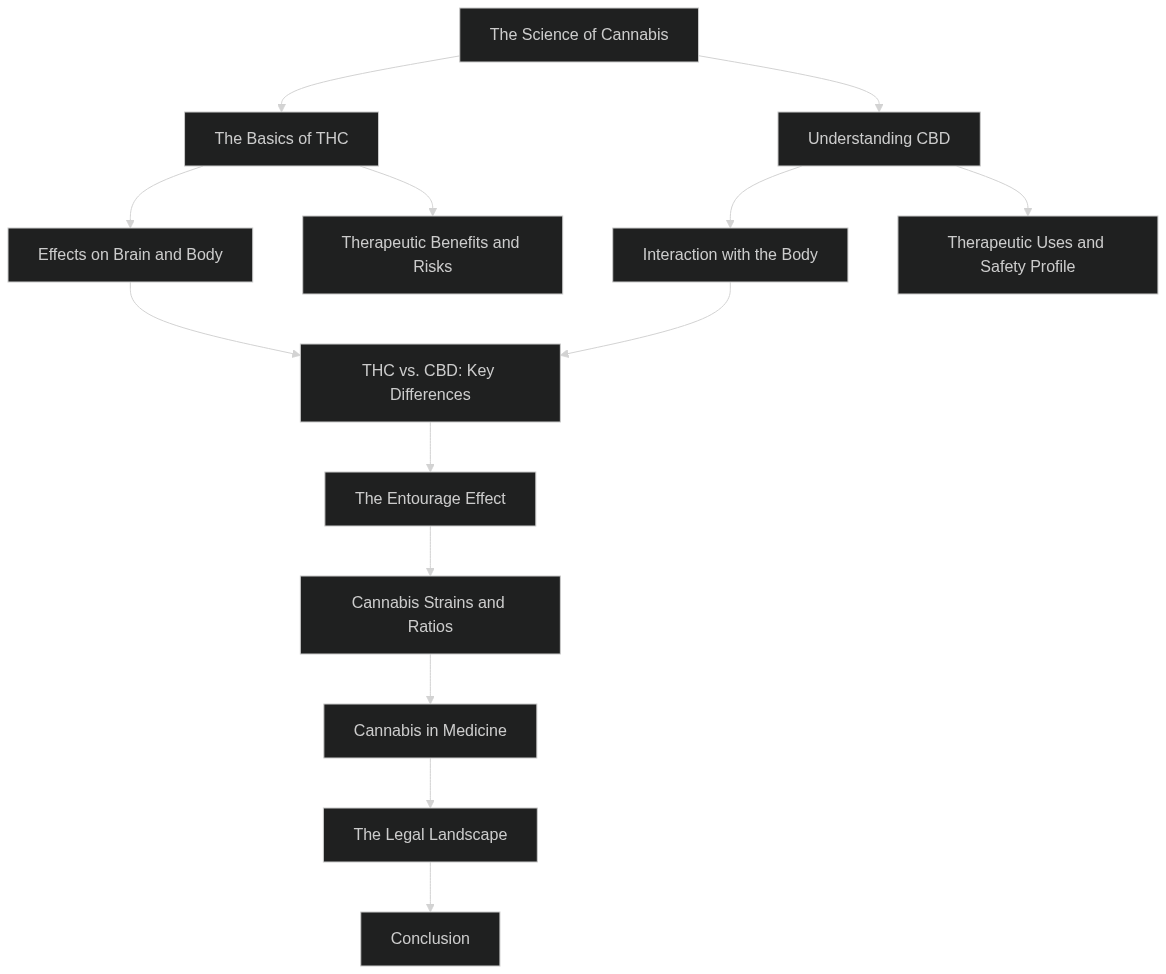THC VS. CBD: DECODING THE SCIENCE BEHIND CANNABIS COMPONENTS
Introduction
Cannabis is renowned not just for its recreational use but also for its potential in therapeutic settings, primarily due to two key compounds: THC (Tetrahydrocannabinol) and CBD (Cannabidiol). These compounds are the most recognized cannabinoids among the plant's over a hundred chemicals and have distinct properties and effects on the human body.
This article will delve into the intricacies of THC and CBD, exploring their biochemical effects, medical benefits, and the social and legal landscape surrounding them. By understanding these compounds, consumers and medical professionals can make informed decisions about their use in therapy and personal wellness.
While THC and CBD both originate from the cannabis plant, they have significantly different effects on the human body.
THC, the primary psychoactive component, induces a "high," characterized by feelings of euphoria and relaxation, but can also cause anxiety and paranoia in some individuals.
In contrast, CBD is non-psychoactive and known for its therapeutic benefits, such as reducing inflammation, pain, and anxiety, without intoxication.
These cannabinoids interact with the human endocannabinoid system in diverse ways, depending on the individual's physiological makeup. The legal landscape also reflects their differences: THC is heavily regulated, while CBD is more widely accepted due to its non-intoxicating properties.
Research from Project CBD, PubMed., the American Chemical Society's Journal, and The Lancet offers extensive insights into their therapeutic potentials and biochemical mechanisms.
The Basics of THC
THC, the primary psychoactive component of cannabis, is renowned for its ability to produce the iconic 'high' associated with marijuana use. Beyond its psychoactive effects, THC interacts with the body's endocannabinoid system, influencing mood, appetite, and pain sensation.
While it offers significant therapeutic benefits, ranging from pain relief to nausea reduction, it also carries risks such as impaired cognitive function and potential dependency in some individuals.
Additionally, THC binds with cannabinoid receptors in the brain, inducing feelings of euphoria and relaxation. It can also alter sensory perceptions, memory, and mood. While these effects are sought after in recreational use, they can also provide therapeutic benefits such as pain relief and stress reduction.
However, THC's psychoactivity can lead to adverse effects like paranoia and anxiety, particularly in higher doses or in sensitive individuals. For those interested in the therapeutic aspects of THC without the high, synthesized versions or lower dosages are often recommended.
Understanding CBD
Contrary to THC, CBD does not induce a psychoactive effect, making it an appealing option for those seeking the therapeutic benefits of cannabis without the high.
CBD's interaction with the body is complex, involving indirect actions on cannabinoid receptors and impacts on various neurotransmitter systems. Its potential therapeutic applications are vast, including anxiety reduction, seizure control, and anti-inflammatory effects.
Additionally, CBD's medical applications are extensive, ranging from treating epilepsy and chronic pain to reducing inflammation and anxiety.
Unlike THC, CBD does not produce a psychoactive effect, making it an appealing option for those seeking relief without the alteration of consciousness. CBD may also modulate the effects of THC, enhancing its medicinal benefits while minimizing potential negative psychoactive effects.
Its utility in a wide range of medical conditions has been supported by clinical trials and health articles, some of which can be accessed for more detailed information at Harvard Health and The Lancet

The theory of the entourage effect suggests that THC and CBD, along with other minor cannabinoids and terpenes in the cannabis plant, work together synergistically to enhance therapeutic effects and reduce side effects.
This concept has encouraged a more holistic approach to cannabis research and product development, where the benefits of whole-plant use are considered greater than the sum of its parts.
The interactions between cannabinoids can vary widely and are influenced by the specific chemical makeup of the product being used. For more information on the entourage effect, consider the scientific discussions available at Scripps Research and detailed research articles on Nature.
Cannabis Strains and Ratios
The diversity of cannabis strains, each with its unique THC:CBD ratio, plays a crucial role in the effects experienced by the user.
Strains high in THC are typically sought after for their potent psychoactive properties, while those rich in CBD are favored for their therapeutic potential without inducing a strong high.
The choice of strain and the THC:CBD ratio should align with the user's desired outcomes, whether for relaxation, pain relief, or other therapeutic purposes. Websites like Leafly and Cannabis.info provide detailed strain guides and reviews to assist in making informed selections.

Cannabis in Medicine
The medical application of cannabis, particularly the use of THC and CBD, is a rapidly expanding field. THC has been used to alleviate symptoms such as chronic pain, glaucoma, and muscle spasticity, while CBD shows promise in treating epilepsy, anxiety disorders, and certain types of cancer.
As research continues to uncover the medicinal properties of these cannabinoids, their integration into conventional treatments could transform aspects of healthcare.
Legal and Regulatory ChallengesNavigating the legal landscape of cannabis use is complex due to varying international laws concerning THC and CBD.
In many places, CBD is legally accessible due to its non-psychoactive nature, whereas THC is often subject to stricter control due to its psychoactive properties.
These legal variations significantly affect the research, development, and accessibility of cannabis-based treatments, which can hinder scientific progress and consumer access to these compounds.
Interested readers can explore the current legal status and ongoing debates through detailed reports at ProCon.org and comprehensive overviews by the Drug Policy Alliance.
Consumer Safety and Market TrendsThe increasing popularity of THC and CBD products raises important concerns regarding consumer safety. Issues such as product mislabeling, contamination, and inconsistent potency can pose significant risks.
As the market expands, regulatory bodies are struggling to keep up, making consumer education and caution more crucial than ever. Consumers are encouraged to seek products from reputable sources

Conclusion
The scientific journey into understanding THC and CBD has unveiled numerous potential benefits and complexities. Both cannabinoids play crucial roles in the therapeutic landscape but come with distinct legal and health implications that require careful consideration.
As research continues to evolve, it will further illuminate the mechanisms by which these compounds operate and how they can be best utilized for health and wellness. Future advancements in cannabis research and regulation will likely provide even greater insights and improved consumer safety measures.
FAQs
Q: What are the main differences between THC and CBD?
A: THC is psychoactive and can produce a high, while CBD is non-psychoactive and won't make you feel intoxicated. THC is often used for its euphoric effects and pain relief, whereas CBD is sought for its potential to relieve anxiety, inflammation, and certain seizure disorders without causing a high.
Q: Can CBD counteract the effects of THC?
A: Yes, CBD can modulate the effects of THC. It can mitigate some of THC's less desired effects, such as anxiety and paranoia, by binding to cannabinoid receptors and reducing THC's ability to activate them.
Q: What is the entourage effect in cannabis?
A: The entourage effect is a theory that suggests the compounds in cannabis, including THC, CBD, and other cannabinoids and terpenes, work together synergistically to enhance their therapeutic benefits more effectively than any single compound alone.
Q: How do I choose the right cannabis strain for my needs?
A: Consider your desired effects: if you're looking for relief without a high, opt for strains with higher CBD levels. For psychoactive effects or stronger pain relief, look for strains with higher THC content. Consulting with a healthcare provider and checking reputable resources can also guide your choice.
Q: Is it legal to use THC and CBD everywhere?
A: The legality of THC and CBD varies widely depending on where you live. While CBD is generally more widely accepted due to its non-psychoactive properties, THC remains illegal in many places. Always check your local laws and regulations regarding cannabis use.
--
"Unlock the secret to organized and stylish cannabis storage with our premium stash boxes - visit our website now to discover your perfect match!"
--








